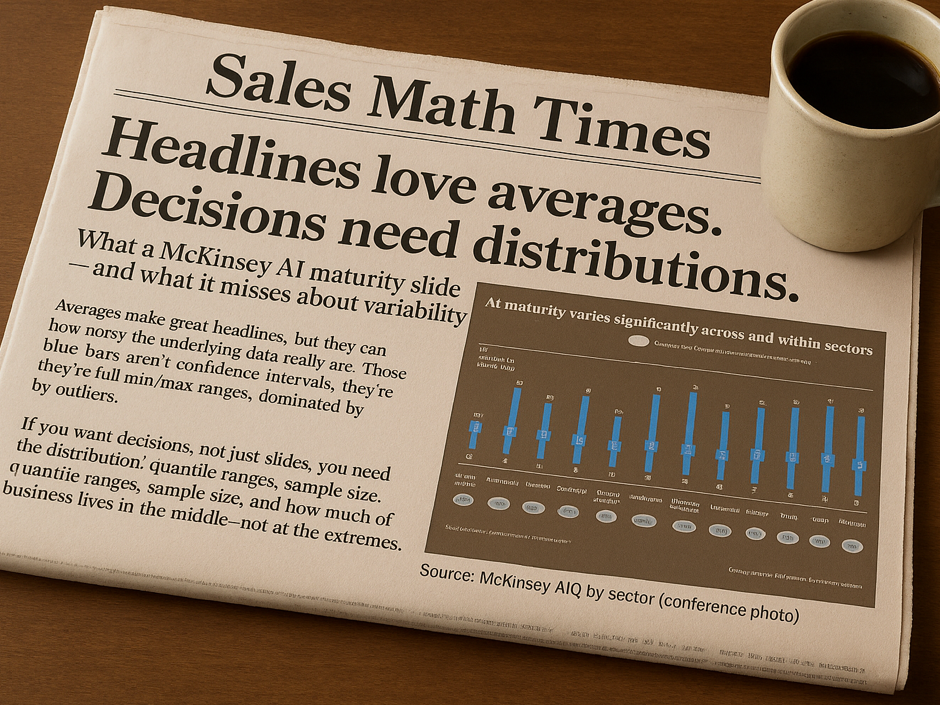How Do We Get There?
- Bryan Lewis

- Jul 13
- 3 min read
Updated: Aug 9
A basic problem in sales optimization goes like this:
You have a goal for the quarter.
You have deals in the pipeline.
Which deals to work on to make the goal?
The complexity of this problem is often underestimated. I've seen managers try to form ad-hoc combinations of deals that add up to a goal. It's much harder than they realize!

Let's illustrate the surprising complexity that arises with a toy example. Here is a tiny pipeline of only 10 deals with random Amounts and Scores (that represent chance of closing in the quarter):
Deal ID | Amount | Score | Deal ID | Amount | Score | |
1 | 59 | 33% | 6 | 14 | 58% | |
2 | 39 | 12% | 7 | 11 | 63% | |
3 | 34 | 29% | 8 | 87 | 17% | |
4 | 51 | 60% | 9 | 68 | 38% | |
5 | 82 | 81% | 10 | 43 | 60% |
If we could magically close every deal, the sum of their amounts is 488. That's a very unlikely goal. If we multiply Amount by Score and add those up, we get a more likely outcome of ≈ 213. Let's use that figure to set a goal of between, say, 220 and 260.
Here's a little puzzle for you: How many distinct ways without re-using numbers are there to add up the 10 Amounts above to get a number between 220 and 260?
Hint: most people guess low.
Answer: There are 187 distinct ways to land between 220 and 260. That's a lot of deal combinations to consider!
If there are that many combinations of deals to reach a goal in this tiny toy example, imagine the enormous complexity of assembling combinations in a larger pipeline of 100 or 200 deals. This simple problem quickly becomes incredibly complex.
Let's get back to the problem: which deals to work on to make the goal.
Now that we know all possible combinations of deals that add up to our desired goal, we can evaluate the expected value ("reward") and risk of each combination, where "risk" is estimated by variance¹ of each reward. We'd like to optimize for high reward and low risk. One simple way to do that is look for the deal combination with the largest reward / risk ratio. Here is a histogram of those ratios for all 187 combinations:

This histogram tells us, among all 187 combinations of deals that add up to our goal of between 220 and 260, there is a wide variation in reward/risk ratios. A few combinations circled in red exhibit the highest reward/risk ratios: perhaps good candidates for deals to work on!
For the record, here is one of the highest reward/risk deal combinations selected by this approach:
Deal ID | Amount | Score |
3 | 34 | 29% |
4 | 51 | 60% |
5 | 82 | 81% |
7 | 11 | 63% |
10 | 43 | 60% |
These deals add up to 221 (in-range of the goal) and mostly exhibit high scores. It's probably close to a typical ad-hoc selection. But remember, this is a small toy example. The number of possible combinations to reach a goal for larger pipelines gets really big really fast, making ad hoc methods less viable.
Enumerating all possible combinations of deals to sum up to a goal is not tractable for large pipelines. Fortunately, there exist many clever mathematical techniques including dynamic programming, branch-and-bound optimization and Monte Carlo simulation that can arrive at a good solution in a reasonable time.
This approach can be tuned in many ways. Maximizing the reward-to-risk ratio is relatively conservative and can be adjusted to admit more or less risk. Or it can be modified to limit numbers of deals to work on. The definition of risk itself can be adjusted to reflect other objectives. The important thing is to focus on high-level risk/reward questions, not on low-level combinatorial details.
Summary
Selecting deals to focus on in a pipeline is a surprisingly complex, computationally-demanding problem.
Automated, systematic methods exist to select reasonable candidate deals with optimal value and risk properties.
Ad-hoc pipeline focus methods are not only time-consuming, but unlikely to arrive at optimal solutions because the problem is so complex. Use these techniques to quickly focus on deals most likely to achieve your goals.
For instance, estimated by Monte Carlo methods like this: https://www.funnelcast.com/post/how-to-do-monte-carlo-simulations-in-excel-and-why-you-d-want-to-do-that




Comments